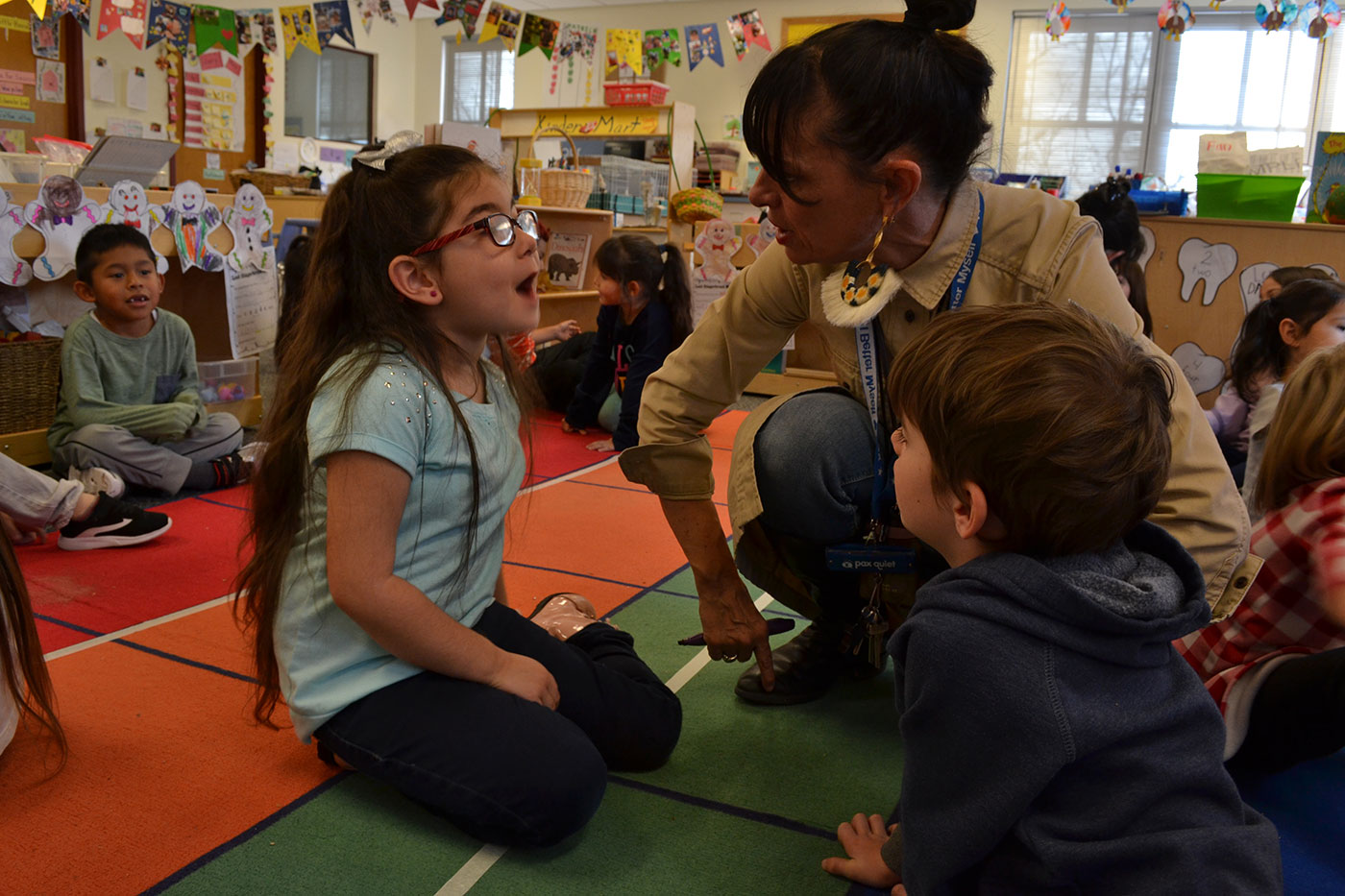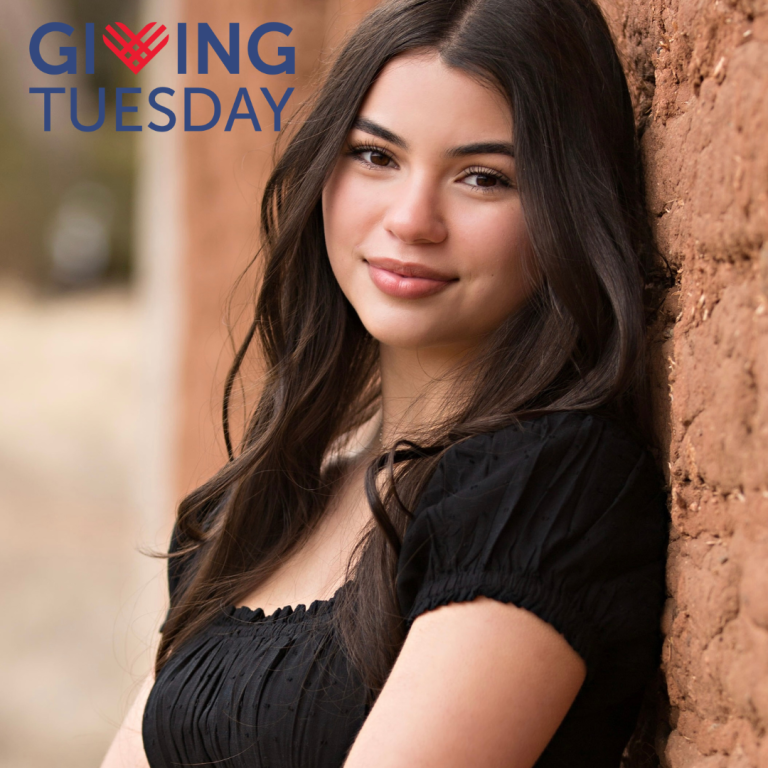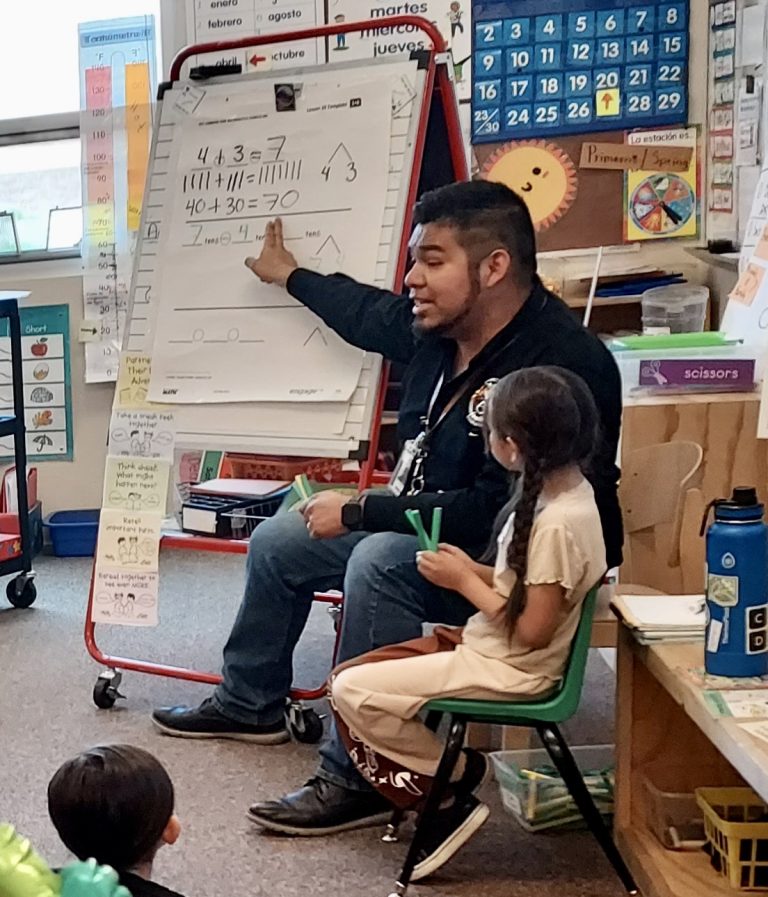Kindergarteners become school meteorologists with the help of Inquiry Science Education Consortium (ISEC) investigations.
It is Amelia’s turn to be meteorologist in Michelle Barnard’s kindergarten class at Tesuque Elementary School. She stands at the front of the room, wearing a pin that reads “Top Banana” and holding a pointer. To the tune of “London Bridge is Falling Down,” teacher Michelle Barnard leads the class in singing “What’s the Weather Like Today?” With an anemometer fashioned from crepe paper and a paper towel tube, Amelia goes outside to check wind speed, temperature and weather conditions. When she returns, she steps into her TV meteorologist role and shares her observations by pointing to information she has posted on the weather board.
Amelia checks windspeed with a handmade anemometer.
Like other members of her class, Amelia is practicing not only to be a scientist but for her film debut. With the help of the school’s digital learning coach, Barbra Clack, the class will end the semester by producing a video. An expert came in to coach them on presentation. For the final filming they will don their Tesuque clothing and their scientist hats and share what they have learned about meteorology and Tesuque weather with the school and the Tesuque community
The video will highlight what the students have learned through their Inquiry Science Education Consortium (ISEC) “Exploring My Weather” unit. Ms. Barnard’s class has been observing the weather and practicing to be meteorologists since the start of the semester, collecting and recording weather data in their journals, learning about different kinds of weather and how it affects their daily lives and running investigations related to weather. The students are so invested that if Ms. Barnard suggests skipping a day, they protest.
Amelia presents the weather report to her classmates.
“I can’t help when they give their forecast, I start to laugh out of joy because it’s just so awesomely cool,” Ms. Barnard said.
In order to consolidate the intensive prep time required for these hands-on lessons, Ms. Barnard teaches several sections in one afternoon rather than spending a half hour a day on an investigation. She plans her activities by working backwards, starting with her favorites, the “Too-Good-to-Miss Science.”
“The enrichment activities are so delightful, so I always say, save a little space for those,” Ms. Barnard said. “ They’re really the ones that I think make a stronger connection, because it kind of links it all together.”
Once she chooses her “Too-Good-to-Miss” activities, Ms. Barnard decides which activities she will use to lead up to those, threading investigations together to make the most efficient use of their time. “Time is our biggest opponent, because we’re trying to get it all in,” she said.
Ms. Barnard finds further efficiency in using Project Based Learning (PBL) in her lesson plans. For example, the ISEC curriculum suggested having the students write a poem about weather. She incorporated GLAD (Guided Language Acquisition Development) strategies into that exercise. The children came up with words that represent weather, then tore them apart and mixed them together to make a group poem.
Today’s investigations revolve around how weather affects humans and animals.
The first exercise explores how weather and clothes go together. Children pair up with a “shoulder partner.” As soon as Ms. Barnard utters the magic word, “bellybutton,” they break into animated conversations about what they would wear on rainy, sunny and snowy days, then take turns sharing those ideas with the group.
“Shoulder Partners” share what they would wear on rainy, sunny and snowy days.
Next they are given journal pages, including a blank sheet for them to draw colored pictures of themselves in their favorite weather, dressed appropriately.
Ms. Barnard leads into the next investigation by saying her friend Betty wants their help designing a doghouse for her new dog.
“She said, Miss Michelle, you have some super scientists in here who are very smart about weather and they understand that weather needs shelter.”
Ms. Barnard explains how engineers use models to test their designs before they build them, and that the children will use their model doghouses (plastic containers) to test foil, newspaper and paper towels as roofing materials. Her “super scientists” are asked to predict which material will work best to keep rain off the dog by forming a line by the material of their choice. One child chooses paper towels, two choose newspapers, the rest crowd into the foil line.
“Lab assistants” for each table pass out trays of materials and make sure that everyone gets a chance to use the eyedropper to simulate rain. After the experiments, the children draw pictures of how each material reacted to water in their journals and finish the sentence “The best roof for the doghouse was made of…” by circling (big word) “aluminum foil.”
LANL Foundation K-12 Professional Development Coordinator Doris Rivera works with students as they test model roofs for a doghouse.
By the end of the investigation, the children are buzzing with excitement. Ms. Barnard brings their attention back to her by starting a game of Simon Says, interspersing directions such as “Simon Says put your journal under your chair.” She is a master of classroom management, smoothly transitioning between activities with call and response phrases the children have obviously memorized: “Hocus, pocus”/ “Time to focus” or “Macaroni and cheese”/ “Everybody freeze.” One child spends most of his time with her educational assistant, but at one point Ms. Barnard brings him into the group while allowing him to maintain some sense of his own space, never missing a beat as she continues the learning activities for the rest of the children.
The day ends with a look at different types of hats and what type of weather they would be suited for. Ms. Barnard summarizes the lessons learned that day with,
“Certain hats, certain clothes, certain materials, help protect us and keep us safe in weather. Meteorologists, when we talk about the weather in Tesuque, do we want to let people know what to wear? Isn’t that our job, scientists?”
Ms. Barnard helps a student with her hat.
The children fashioning their own hats out of paper plates, deciding on the style and what type of weather their hat will protect them from. They have run out of time, so the Meaning Making Circle will wait until tomorrow morning.
Ms. Barnard summed up her approach to teaching science to this age group. “I feel my job as a kindergarten teacher is to help them become scientists: managing and respecting their tools, knowing that they’re going to give them data and evidence and the evidence is how they draw their conclusions.”
The final project of the semester was creating a video of the little meteorologists sharing the date they had gathered about Tesuque weather. You can watch the video HERE.



